Domnev1
IPSec Tunnel w/CA Certs Configuration
Introduction
In computing, Internet Protocol Security (IPsec) is a secure network protocol suite of IPv4 that authenticates and encrypts the packets of data sent over an IPv4 network. IPsec includes protocols for establishing mutual authentication between agents at the beginning of the session and negotiation of cryptographic keys to use during the session. IPsec can protect data flows between a pair of hosts (host-to-host), between a pair of security gateways (network-to-network), or between a security gateway and a host (network-to-host). Internet Protocol security (IPsec) uses cryptographic security services to protect communications over Internet Protocol (IP) networks. IPsec supports network-level peer authentication, data-origin authentication, data integrity, data confidentiality (encryption), and replay protection.
This article provides an extensive configuration example with details on how to create a tunnel connection authenticating with X.509 Certs between two IPsec instances, both of which configured on RUTxxx routers.
Configuration overview and prerequisites
Before we begin, let's overview the configuration that we are attempting to achieve and the prerequisites that make it possible.
Prerequisites:
- Two RUTxxx routers of any type
- Both RUTxxx routers must be accessible from each other's WAN connection
- Firmware for the devices must be 00.07.xx.x or above. This is in part to make sure the StrongSwan service is U5.9.6 or >
- An end device (PC, Laptop) for configuration
- (Optional) A second end device to test remote LAN access
[Image Here showing RUT1 & RUT2 connected via Wan connection] [RUT1 Wan IP: 192.168.1.3 Lan IP: 192.168.3.1] [RUT2 Wan IP: 192.168.1.14 Lan IP: 192.168.14.1]
The figure above depicts two RUTxxx routers (RUT1 and RUT2) connected by an IPsec tunnel via their WAN interfaces.
Router configuration
We will start our configuration with RUT1.
This configuration guide will generate our own CA cert that will be used to self-sign our own keys and local certs for both devices.
Generating Certs
Generating CA Cert
First we will generate our CA cert.
- Login to the router's WebUI and go to System → Administration → Certificates.
The following are the settings used for this example, but values should be changed depending on your specific needs:
- File Type: CA
- Key Size: 1024
- Name (CN): CAIPSec // This can be whatever name you choose.
- Subject Information: Toggled On // It is recommended to fill out at least Country Code, State/Province and Organization Name.
- Country Code (CC): US // Fill your country code
- State or Province Name (ST): TX // Fill your State/Province name
- Locality Name (L): CAIPSec // Fill your locality name, or at least a recognizable name for your CA
- Organization Name (O): CAIPSec // Fill your Organization name
- Organizational Unit Name (OU): CAIPSEC // Fill your specific Unit Name
- Generate Certificate
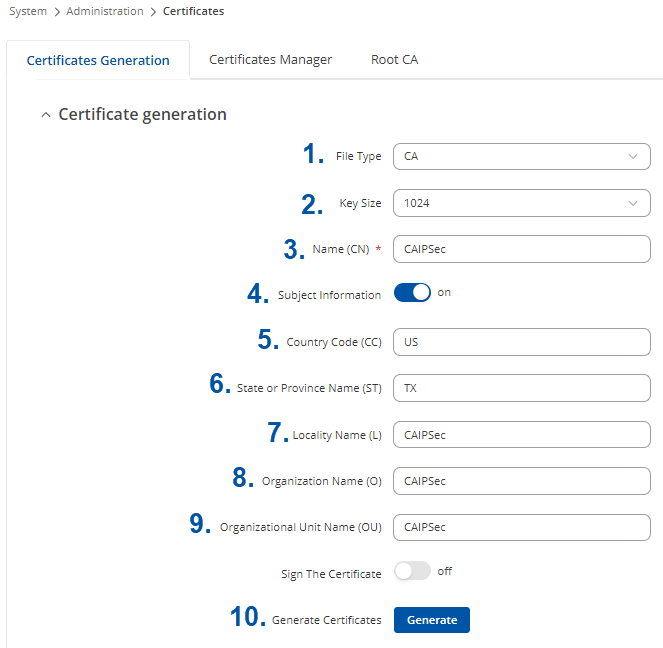
After you hit Generate the CA cert you should see a confirmation notification pop-up near the top right, and if you select Certificates Manager you should see a CAIPSec.key.pem under *Keys* and a CAIPSec.req.pem under *Certificate requests*.


Next we need to sign the CAIPSec CA. We will be Self-Signing our own CA.
Under the Certificate signing configure as follows:
- Signed Certificate Name: CAIPSec
- Type of Certificate to Sign: Certificate Authority
- Certificate Request File: CAIPSec.req.pem
- Days Valid: 3650 // For this example we will use 3650 days, but you can configure this to be longer if needed. I would caution against too long of a CA.
- Certificate Authority Key: CAIPSec.key.pem
- Leave the rest of the configuration default
- Sign
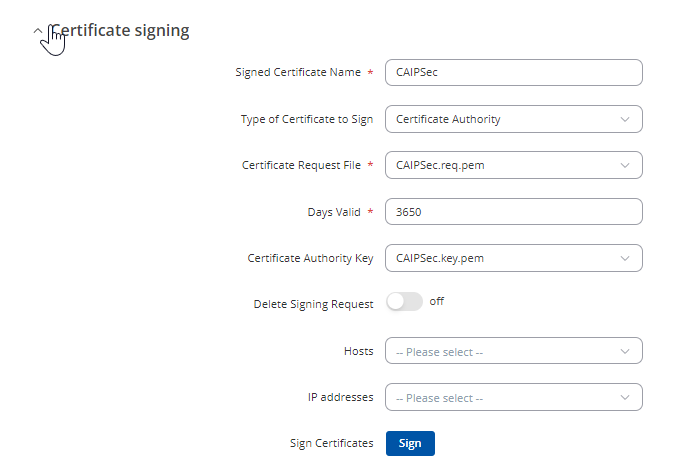
After you hit *Sign* the CA cert you should see a notification pop-up near the top right, and if you select Certificates Manager you should see a CAIPSec.cert.pem under *Certificates*.
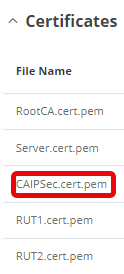
Generating Rut1 Client Cert
- Login to the router's WebUI and go to System → Administration → Certificates.
The following are the settings used for this example, but values should be changed depending on your specific needs:
- File Type: Client
- Key Size: 1024
- Name (CN): RUT1 // This can be whatever name you choose.
- Subject Information: Toggled On // It is recommended to fill out at least Country Code, State/Province and Organization Name.
- Country Code (CC): US // Fill your country code
- State or Province Name (ST): TX // Fill your State/Province name
- Locality Name (L): RUT1 // Fill your locality name, or at least a recognizable name for your CA
- Organization Name (O): RUT1 // Fill your Organization name
- Organizational Unit Name (OU): RUT1 // Fill your specific Unit Name
- Generate Certificate
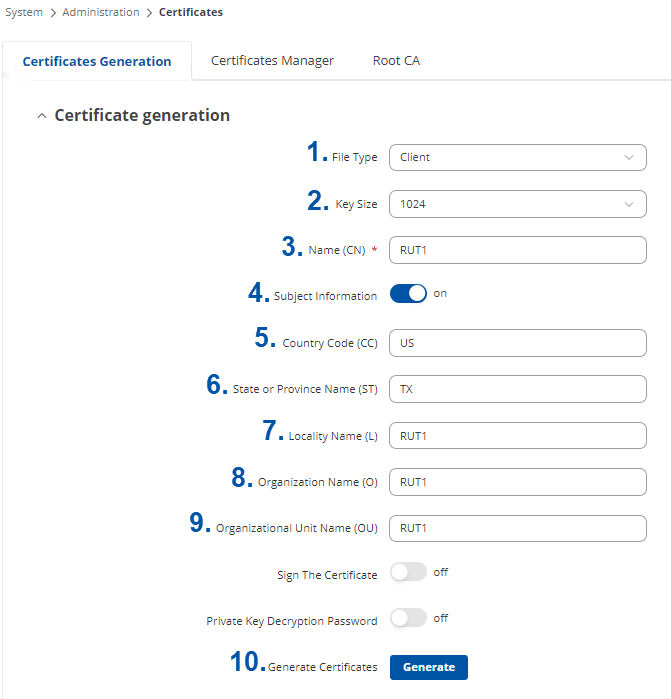
After you hit Generate the Client cert you should see a notification pop-up near the top right, and if you select Certificates Manager you should see a RUT1.key.pem under *Keys* and a RUT1.req.pem under *Certificate requests*.
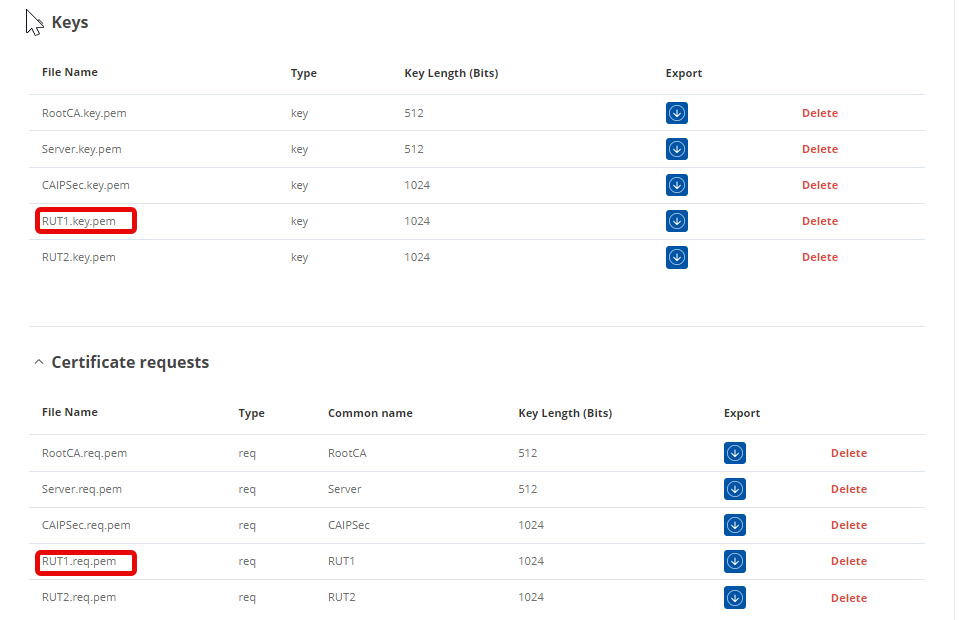
Next we need to sign the RUT1 cert. Under the `Certificate signing` configure as follows:
- Signed Certificate Name: RUT1
- Type of Certificate to Sign: Client Certificate
- Certificate Request File: RUT1.req.pem
- Days Valid: 3650
- Certificate Authority File: CAIPSec.cert.pem
- Certificate Authority Key: CAIPSec.key.pem
- Leave the rest of the configuration alone
- Sign
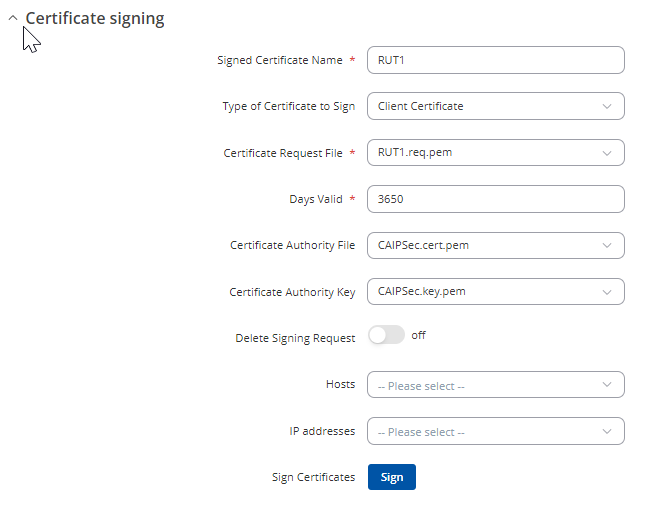
After you hit *Sign* the Client cert you should see a notification pop-up near the top right, and if you select Certificates Manager you should see a RUT1.cert.pem under *Certificates*.
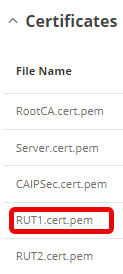
Generating Rut2 Client Cert
We will still generate RUT2 certs on the RUT1 device, so that we can sign our certs with the CA created earlier. Later we will download the certs required for RUT2 and import them there.
- Login to the router's WebUI and go to System → Administration → Certificates.
The following are the settings used for this example, but values should be changed depending on your specific needs:
- File Type: Client
- Key Size: 1024
- Name (CN): RUT2 // This can be whatever name you choose.
- Subject Information: Toggled On // It is recommended to fill out at least Country Code, State/Province and Organization Name.
- Country Code (CC): US // Fill your country code
- State or Province Name (ST): TX // Fill your State/Province name
- Locality Name (L): RUT2 // Fill your locality name, or at least a recognizable name for your CA
- Organization Name (O): RUT2 // Fill your Organization name
- Organizational Unit Name (OU): RUT2 // Fill your specific Unit Name
- Generate Certificate
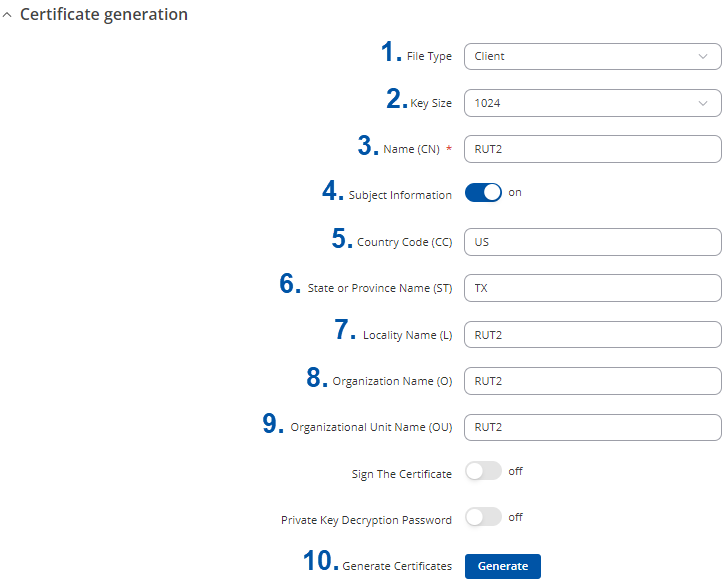
After you hit Generate the Client cert you should see a notification pop-up near the top right, and if you select Certificates Manager you should see a RUT2.key.pem under *Keys* and a RUT2.req.pem under *Certificate requests*.
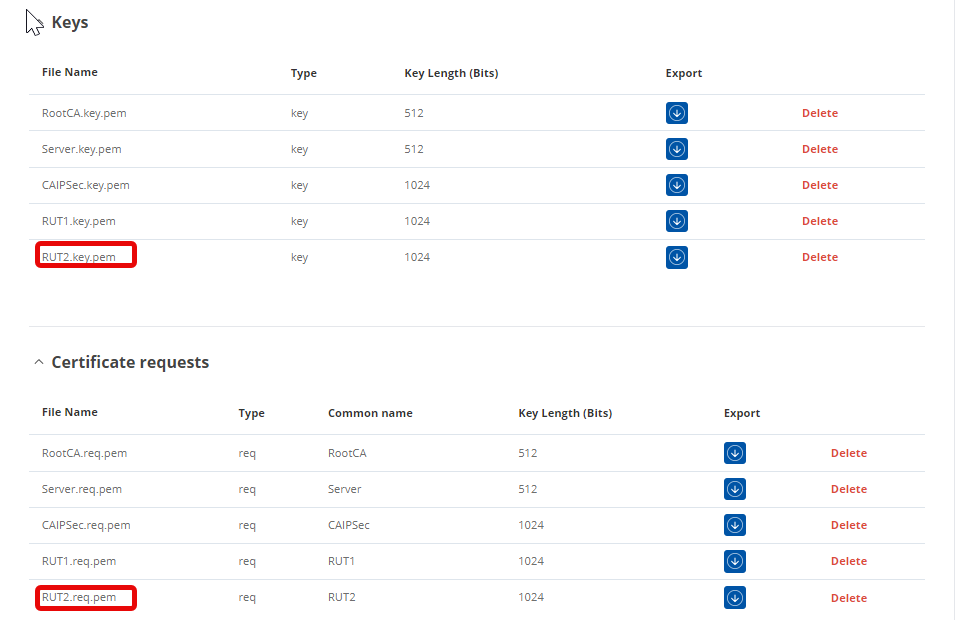
Next we need to sign the RUT2 cert.
Under the `Certificate signing` configure as follows:
- Signed Certificate Name: RUT2
- Type of Certificate to Sign: Client Certificate
- Certificate Request File: RUT2.req.pem
- Days Valid: 3650
- Certificate Authority File: CAIPSec.cert.pem
- Certificate Authority Key: CAIPSec.key.pem
- Leave the rest of the configuration alone
- Sign
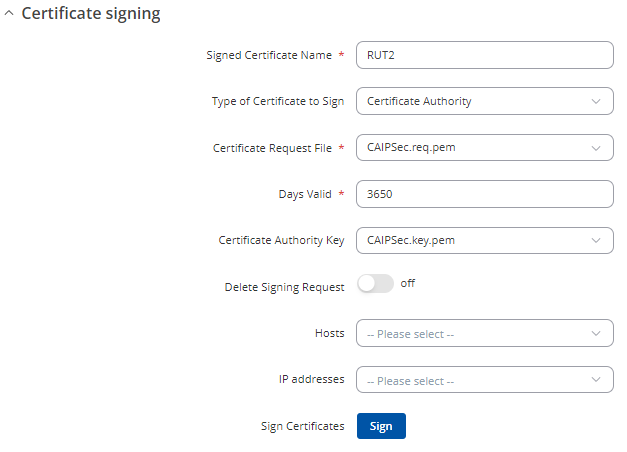
After you hit *Sign* the Client cert you should see a notification pop-up near the top right, and if you select Certificates Manager you should see a RUT2.cert.pem under *Certificates*.
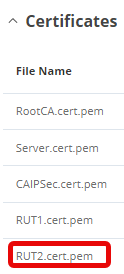
Download/Import Certs
Starting with RUT1
- Login to the router's WebUI and go to System → Administration → Certificates -> Certificates Manager
- Download CAIPSec.cert.pem, RUT1.cert.pem, RUT1.key.pem, RUT2.cert.pem & RUT2.key.pem
- Go to System → Administration → Certificates -> Root CA. Toggle On. Select CAIPSec.cert.pem -> Upload & then Save
Next moving to RUT2
- Login to the router's WebUI and go to System → Administration → Certificates -> Certificates Manager
- Import Certificate File *Browse* and import CAIPSec.cert.pem, RUT1.cert.pem, RUT2.cert.pem & RUT2.key.pem
- Go to System → Administration → Certificates -> Root CA. Toggle On. Select CAIPSec.cert.pem -> Upload & then Save
IPSec RUT1 Config
- Login to the router's WebUI and go to System → Services → VPN -> IPsec
- Add a new instance called CA_EX
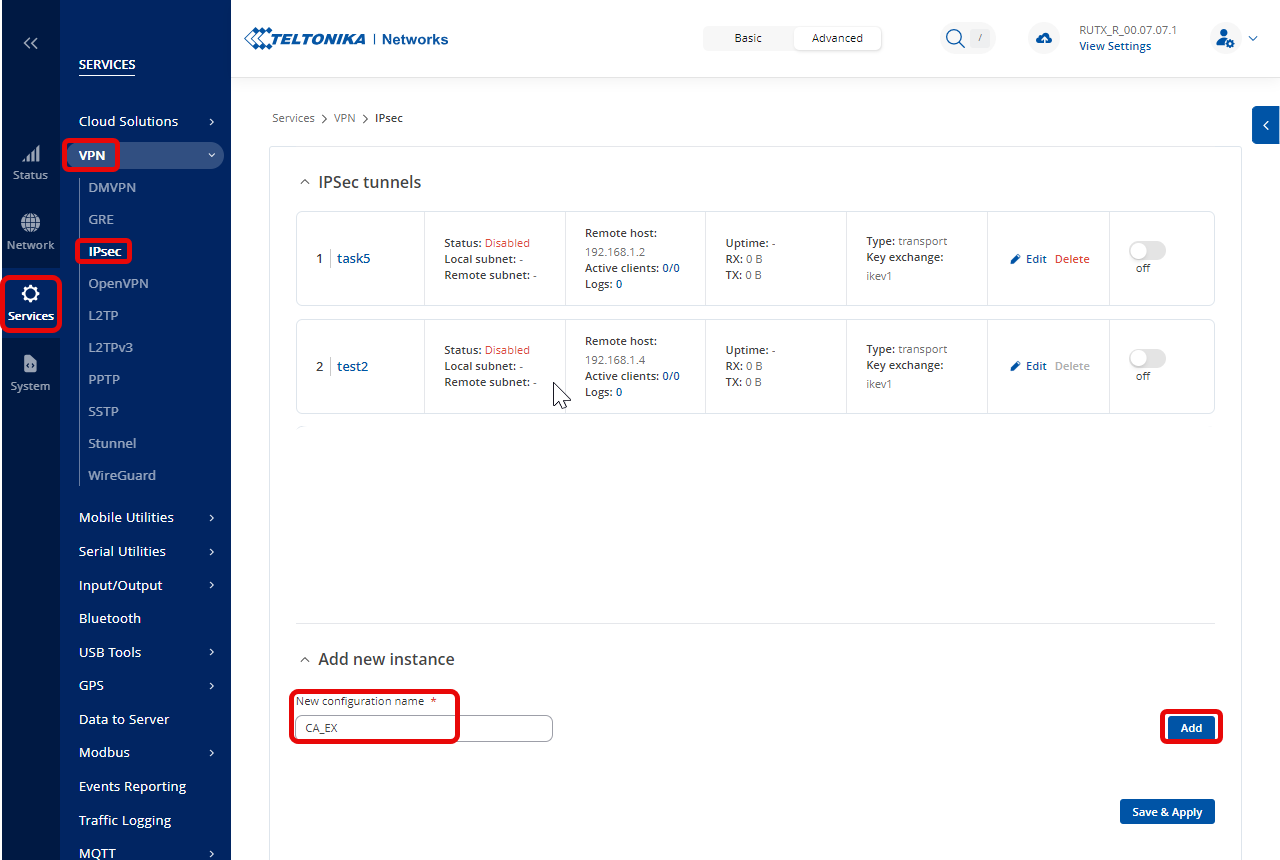
- IPsec Instance General settings configuration as follows:
- Remote endpoint: 192.168.1.14 // This should be RUT2 WAN IP. You should be able to ping this IP from RUT1 WAN IP.
- Authentication method: X.509
- Key: RUT1.key.pem // Browse and import the RUT1.key.pem we created & downloaded earlier.
- Key decryption passphrase: Leave blank // This is only needed if an additional password was added to the cert, which we did not do in our earlier steps.
- Local certificate: RUT1.cert.pem // Browse and import the RUT1.cert.pem we created & downloaded earlier.
- CA certificate: CAIPSec.cert.pem // Browse and import the CAIPSec.cert.pem we created & downloaded earlier.
- Local identifier: 192.168.3.1 // We will use the LAN IP of RUT1 for the Identifier
- Remote identifier: 192.168.14.1 // We will use the LAN IP of RUT2 for the Identifier
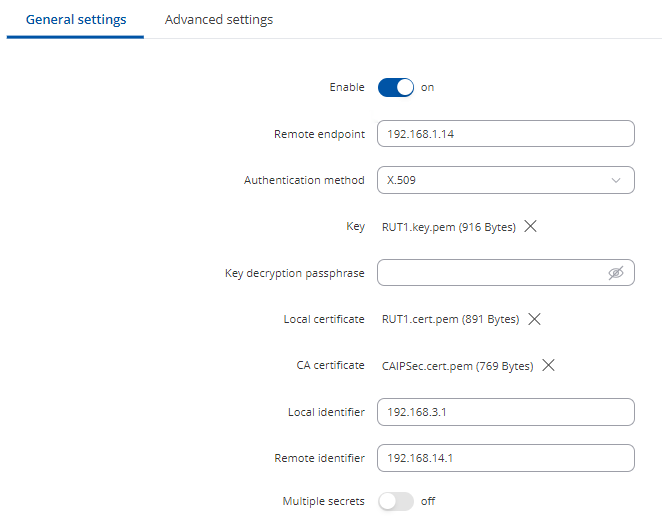
- IPsec Instance Advanced settings configuration as follows:
- Remote certificate: RUT2.cert.pem // Upload RUT2 cert we created earlier.

- Connection settings General settings configuration as follows:
- Mode: Start // start loads a connection and brings it up immediately. For more configuration information please reference *auto* here (https://wiki.strongswan.org/projects/strongswan/wiki/Connsection)
- Type: Tunnel
- Default route: off // Only use this if you want your default route to be out this tunnel.
- Local subnet: 192.168.3.0/24 // RUT1 LAN subnet we want access to through the tunnel
- Remote subnet: 192.168.14.0/24 // RUT2 LAN subnet we want access to through the tunnel
- Key exchange: IKEv2
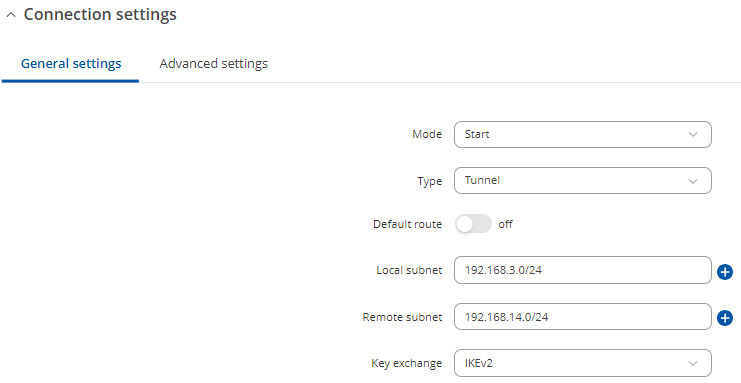
- Connection settings Advanced settings configuration as follows:
- Force encapsulation: On
- Local Firewall: On
- Remote Firewall: On
- Inactivity: 3600 // This is in seconds. Can be changed depending on how often you want the tunnel to be checked for data passing.
- Dead peer detection: On
- DPD action: Restart
- DPD delay: 30 // This is in seconds.
- DPD Timeout: 150 // This is in seconds.
- The rest of the configuration leave as default
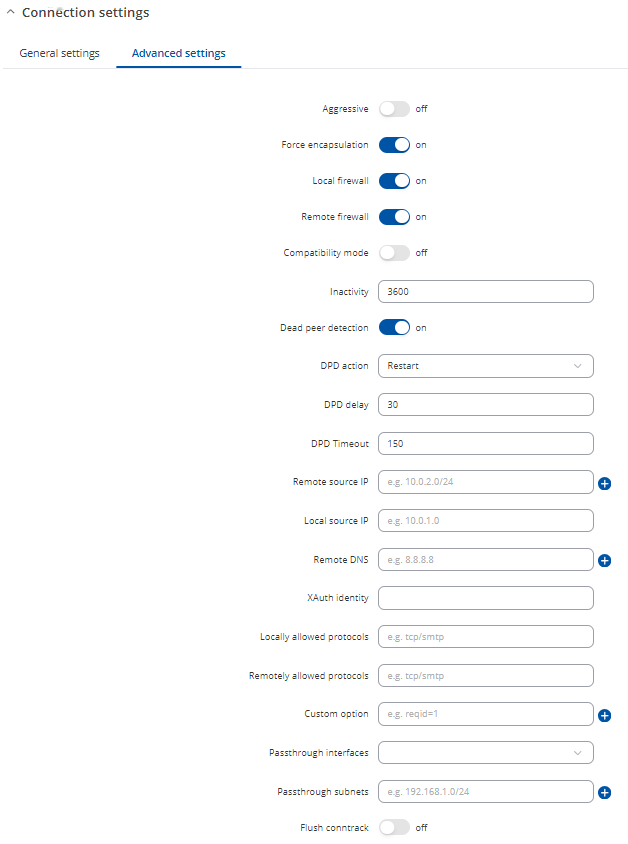
- Connection settings Proposal settings configuration as follows:
- Phase 1
- Proposals // It is VERY important that these settings match between both RUT1 & RUT2
- Encryption: AES 128
- Authentication: SHA1
- DH group: MODP1536
- Force crypto proposal: Off
- IKE lifetime: 3h
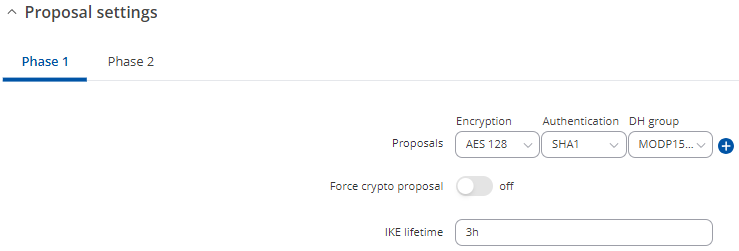
- Phase 2
- Proposals // It is VERY important that these settings match between both RUT1 & RUT2
- Encryption: AES 128
- Hash: SHA1
- PFS group: MODP1536
- Force crypto proposal: Off
- IKE lifetime: 3h
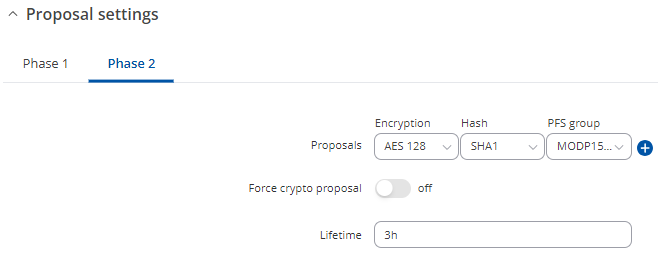
- Hit Save & Apply
- Toggle the CA_EX tunnel on and hit Save & Apply once more
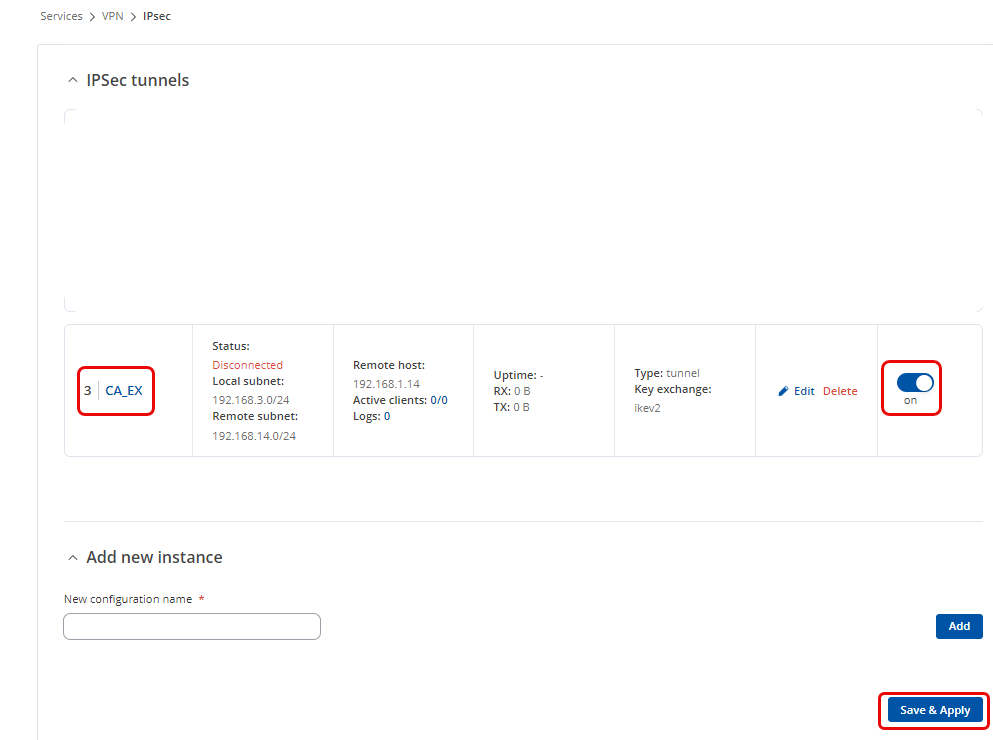
- Reboot the device once you have finished.
IPSec RUT2 Config
- Login to the router's WebUI and go to System → Services → VPN -> IPsec
- Add a new instance called CA_EX

- IPsec Instance General settings configuration as follows:
- Remote endpoint: 192.168.1.3 // This should be RUT1 WAN IP. You should be able to ping this IP from RUT2 WAN IP.
- Authentication method: X.509
- Key: RUT2.key.pem // Browse and import the RUT2.key.pem we created & downloaded earlier.
- Key decryption passphrase: Leave blank // This is only needed if an additional password was added to the cert, which we did not do in our earlier steps.
- Local certificate: RUT2.cert.pem // Browse and import the RUT1.cert.pem we created & downloaded earlier.
- CA certificate: CAIPSec.cert.pem // Browse and import the CAIPSec.cert.pem we created & downloaded earlier.
- Local identifier: 192.168.14.1 // We will use the LAN IP of RUT2 for the Identifier
- Remote identifier: 192.168.3.1 // We will use the LAN IP of RUT1 for the Identifier
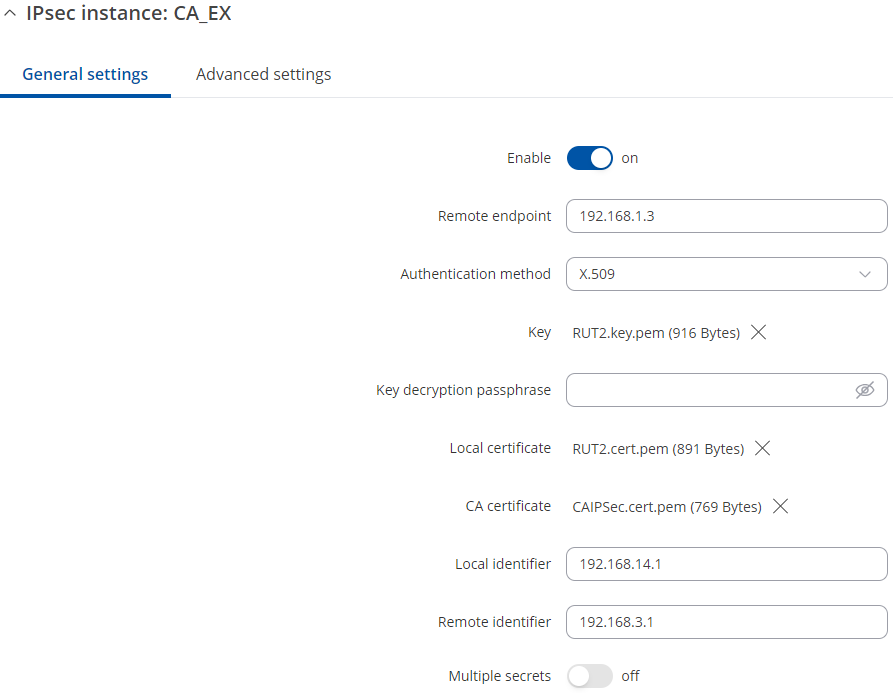
- Connection settings Advanced settings configuration as follows:
- Remote certificate: RUT1.cert.pem // Upload RUT1 cert we created earlier.

- Connection settings General settings configuration as follows:
- Mode: Start // start loads a connection and brings it up immediately. For more configuration information please reference *auto* here (https://wiki.strongswan.org/projects/strongswan/wiki/Connsection)
- Type: Tunnel
- Default route: off // Only use this if you want your default route to be out this tunnel.
- Local subnet: 192.168.14.0/24 // RUT2 LAN subnet we want access to through the tunnel
- Remote subnet: 192.168.3.0/24 // RUT1 LAN subnet we want access to through the tunnel
- Key exchange: IKEv2
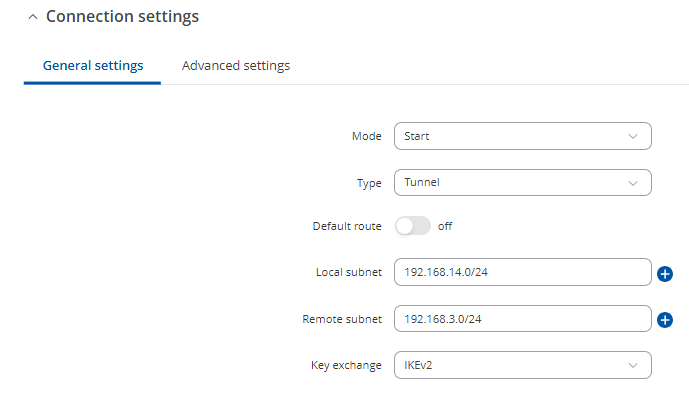
- Connection settings Advanced settings configuration as follows:
- Force encapsulation: On
- Local Firewall: On
- Remote Firewall: On
- Inactivity: 3600 // This is in seconds. Can be changed depending on how often you want the tunnel to be checked for data passing.
- Dead peer detection: On
- DPD action: Restart
- DPD delay: 30 // This is in seconds.
- DPD Timeout: 150 // This is in seconds.
- The rest of the configuration leave as default
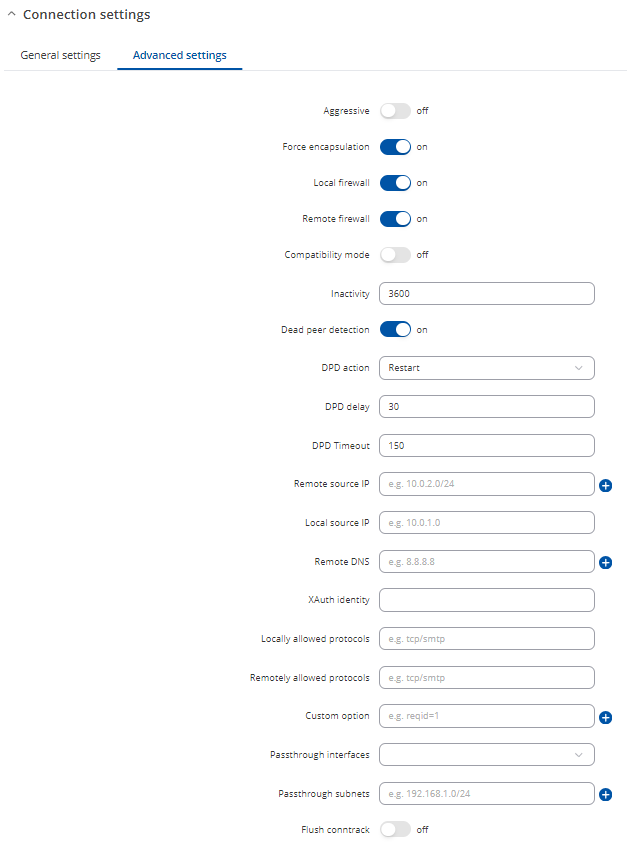
- Connection settings Proposal settings configuration as follows:
- Phase 1
- Proposals // It is VERY important that these settings match between both RUT1 & RUT2
- Encryption: AES 128
- Authentication: SHA1
- DH group: MODP1536
- Force crypto proposal: Off
- IKE lifetime: 3h
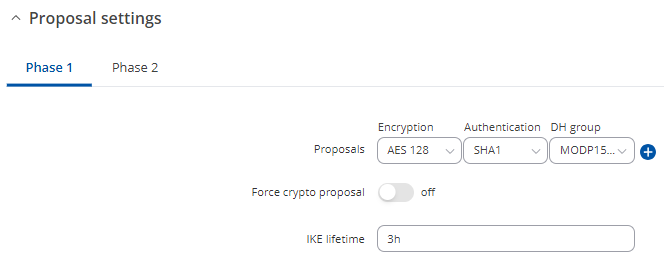
- Phase 2
- Proposals // It is VERY important that these settings match between both RUT1 & RUT2
- Encryption: AES 128 - Hash: SHA1 - PFS group: MODP1536 - Force crypto proposal: Off
- IKE lifetime: 3h
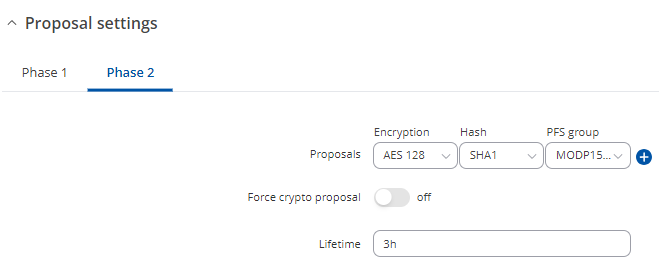
- Hit Save & Apply
- Toggle the CA_EX tunnel on and hit Save & Apply once more
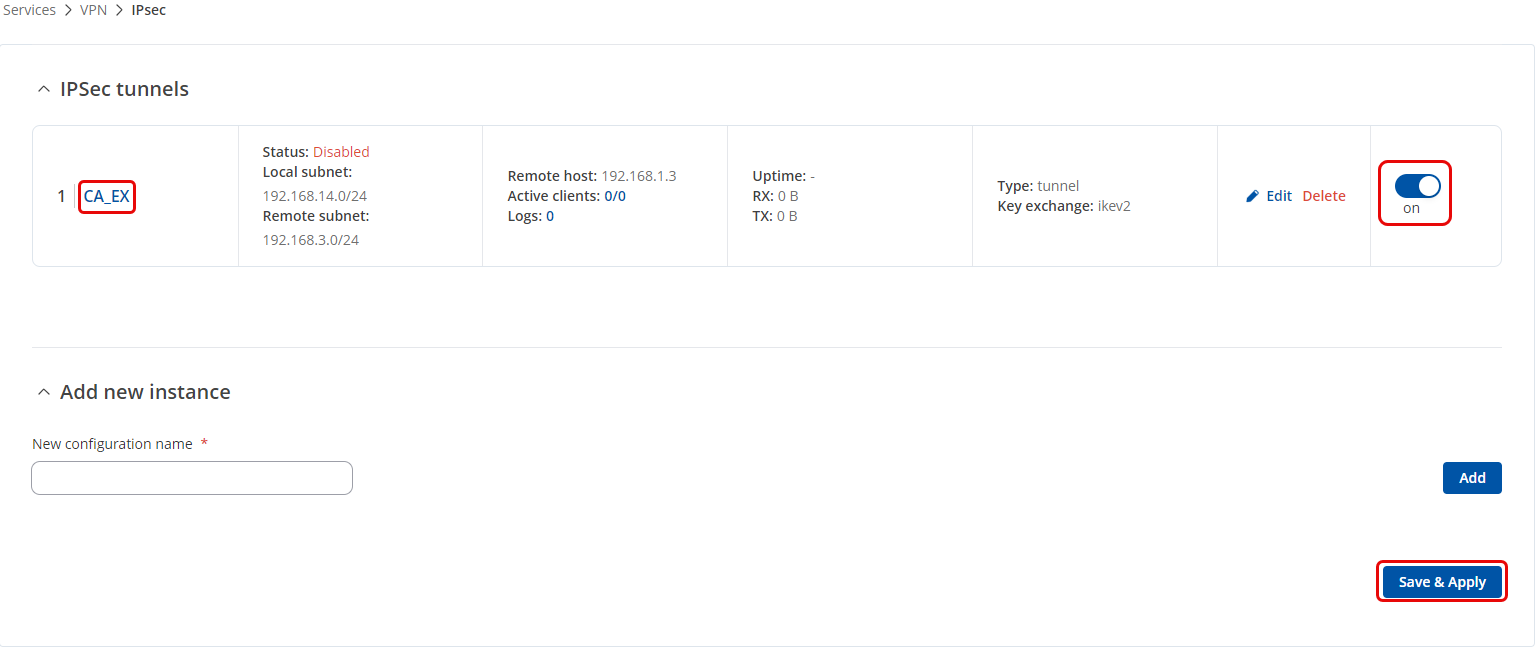
- Reboot the device once you have finished.
Testing configuration
RUT1 to RUT2 Test
Here we will check via SSH on both RUT1 & RUT2 devices that the IPsec tunnel has been established. That each RUT device can ping the other's LAN IP. In this case 192.168.3.1 for RUT1 & 192.168.14.1 for RUT2. And that LAN device on RUT1 can ping LAN device on RUT2.
- First make sure each device has been rebooted at least once after you have finished configuring the previous steps.
- SSH into RUT1 device
- ipsec statusall // This should show 2 up with Security Associations and that the connection should be up for some minutes. You should also see the Cert info from the certs we created earlier.

- ping 192.168.14.1 // You should get a response if the tunnel has established properly
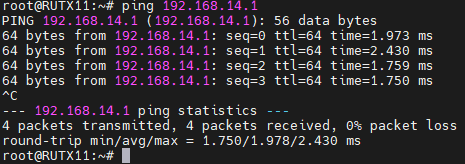
- SSH into RUT2 device
- ipsec statusall // This should show 2 up with Security Associations and that the connection should be up for some minutes. You should also see the Cert info from the certs we created earlier.

- ping 192.168.3.1 // You should get a response if the tunnel has established properly
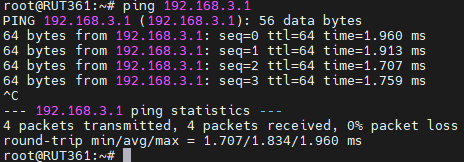
- SSH into RUT1 device
- opkg update
- opkg install tcpdump
- tcpdump -i any -w Checking_For_ESP_Packets.pcap
- SSH into RUT2 device
- On RUT2 ping the LAN ip for RUT1 and leave that running. In our example that would be `ping 192.168.3.1`
- On RUT1 wait 10 seconds then CTRL+C to stop the program
- Then use a program like WinSCP to download Checking_For_ESP_Packets.pcap from RUT1
- Open the file in a program called Wireshark and filter for encrypted ESP packets with this _ws.col.protocol == "ESP". You should see ESP packets from both the WAN IPs. You shouldn't be able to see inside the packet because it is now encrypted, but if we decrypted the packets we would see the ICMP packets between the 2 RUT devices.
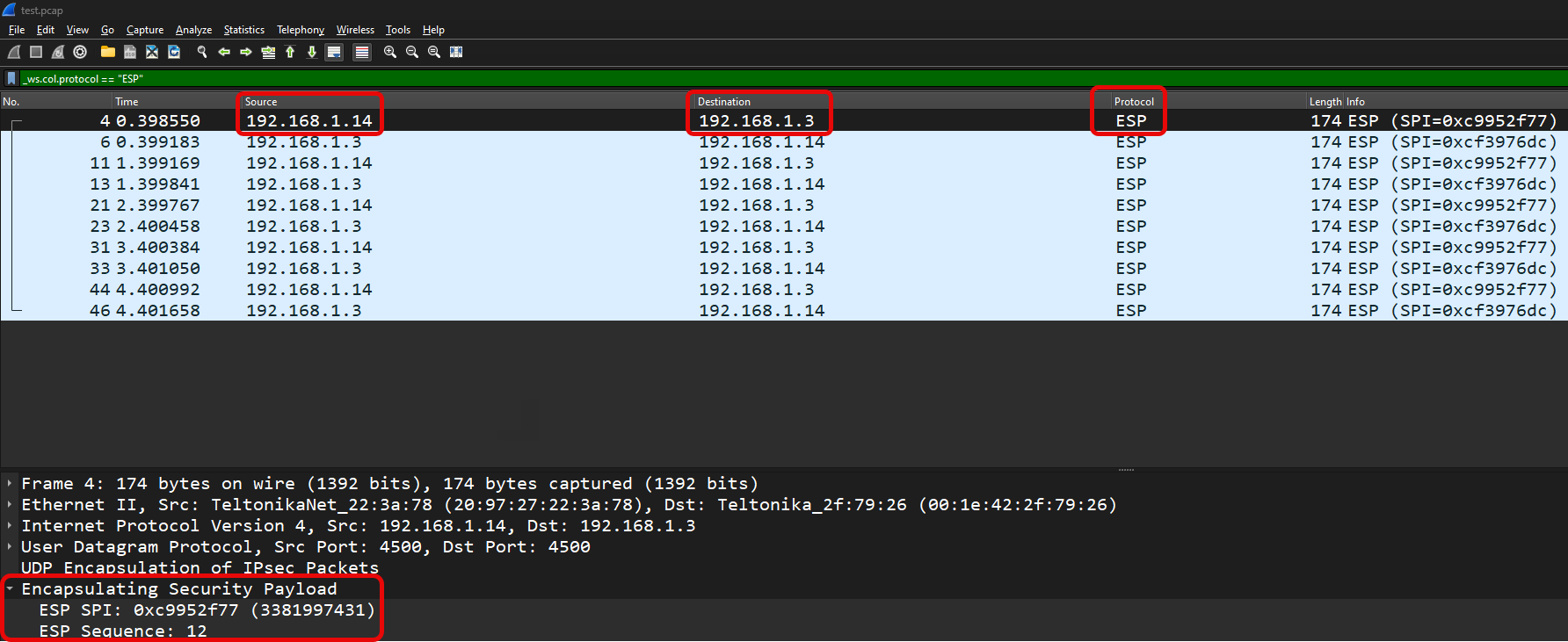
RUT1 LAN device to RUT2 LAN device Test
Here we will confirm that LAN devices behind either RUTxxx devices are able to communicate with each other.
- Attach a Windows/MacOS/Linux PC via ethernet or wifi to RUT1 LAN. Remove or disable any other active interfaces on your PC.
- Disable the firewall. Examples for each OS as follows.
* Windows 10/11 1. Press Windows-Key + R 2. Type control and hit enter 3. Navigate to Firewall Settings -> System and Security -> Windows Defender Firewall 4. On the left sidebar, click "Turn Windows Defender Firewall on or off" 5. Select "Turn off Windows Defender Firewall (not recommended)" under both the Private and Public network settings 6. Click "OK" to apply the changes * MacOS Ventura 1. Click on Apple menu and select "System Preferences" 2. Click on "Security & Privacy" 3. Click on the "Firewall" tab 4. Select the lock icon at the bottom left and enter your administrator password 5. Select "Turn Off Firewall" * Linux (Ubuntu) 1. Open a Terminal window 2. sudo ufw disable
- Perform similar steps above for a 2nd device connected to RUT2 LAN
- Once both devices are connected to the LAN of RUT1 & RUT2 you should be able to ping the devices from each other.
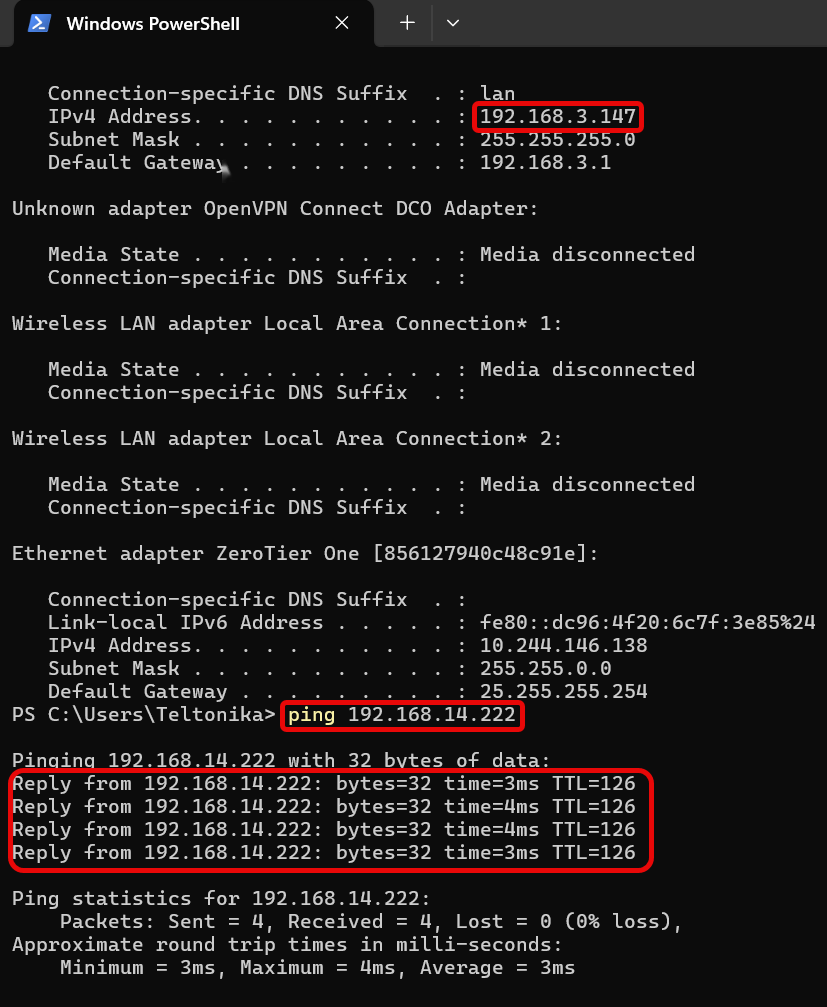
- Afterwards make sure to re-enable the firewall for both LAN devices
